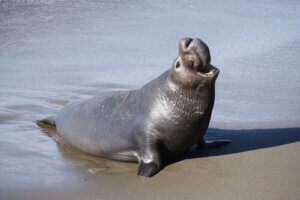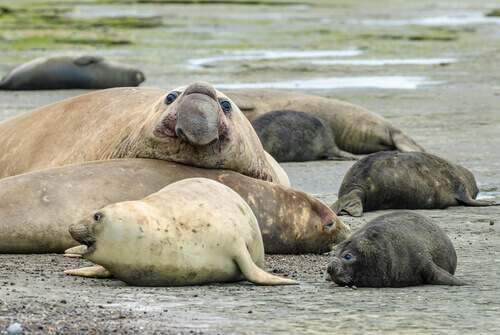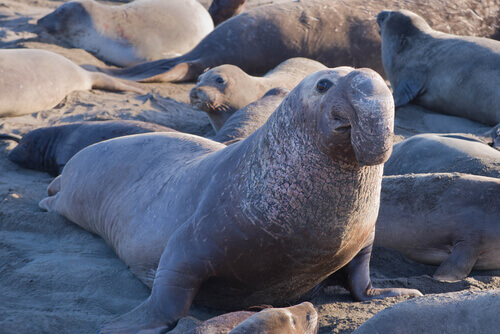The Elephant Seal, a Lifetime in the Cold

The elephant seal is a mammal belonging to the seal species, with unique characteristics and behavior within the animal kingdom. Its scientific name is Mirounga leonina and it spends most of its life in the ocean, coming ashore during the breeding and pupping season.
For many years, they’ve been investigated to find out how they manage to survive in the coldest areas of the planet. The data collected are surprising and we’ll share them below.
General characteristics of the elephant seal
There are two known species of elephant seals. Those of the south, which inhabit the entire Antarctic area, and those of the north, which inhabit the North Pacific, ranging from Baja California, Mexico, to the Gulf of Alaska, and the Aleutian Islands. Although both species are similar, they have some peculiarities that differentiate them.
The elephant seals that live in the south of the planet have to endure extremely cold temperatures, but that’s where food is plentiful. For this reason, their size is much larger than those in the north; they feed on fish, squid, small sharks, crustaceans, algae, and krill.
Males can reach up to 20 feet in length and weigh up to 8820 pounds. Females are smaller and can measure up to 10 feet and weigh up to 1985 pounds. This difference in size between males and females is one of their peculiarities; they’re the mammal with the highest degree of sexual dimorphism.
Males reach sexual maturity at six years of age but begin to procreate at nine. In the months of December and January, elephant seals arrive on the beaches and begin battles for dominance. Although these fights are fierce, they’re not life-threatening.

High sexual activity
Dominant males mate with females that arrive later, and form harems of up to 100 ‘wives’ to give birth to up to 500 offspring in their lifetime. Elephant seals left on the sidelines will attempt to breed with females on the periphery of the harems.
At three years of age, the female is ready to give birth to one calf per year. Once pregnant, they return to the sea and come back to land 11 months later to give birth.
The calves are born weighing almost 90 pounds and nurse for three weeks. During this period, the mother stays on the beach, without feeding. When weaning occurs, mother and calf go into the ocean; the calf triples its weight while feeding on its mother’s milk. Near the end of this period, the female mates again.
Other interesting facts about the elephant seal
Despite their large size, elephant seals move quite agilely on land, thanks to their five-toed webbed flippers; their torpedo shape makes them even faster when swimming. They have large black eyes, which allow them to locate their prey in the darkness of the deep sea.
These curious marine animals store a large amount of blubber while in the ocean to survive in the winter when they stay on land hibernating.
When it comes to diving for long periods of time, polar elephants must maintain high oxygen levels. To achieve this, they have higher blood volume and produce twice as much hemoglobin.

Where does their name come from?
They owe their name to the ‘trunk’ that males have on their noses, which resembles that of elephants. This protrusion is used to produce loud roars that help keep rivals away. In addition, with their trunk, they absorb moisture from the environment with each exhalation, which allows them to fast for long periods of time.
The elephant seal is the only mammal that migrates twice a year, covering up to 21,125 miles. Although they’re seen in large groups on land, they live a solitary life, spending 90% of their existence in the water.
The enormous size of elephant seals doesn’t mean that they don’t have any predators. They’re hunted by killer whales and sharks, but their biggest predators are humans, who have almost extinguished the species, as they hunt them for their blubber.
However, little by little, and thanks to protection and conservation laws, the elephant seal population is now over 900,000 worldwide.
This text is provided for informational purposes only and does not replace consultation with a professional. If in doubt, consult your specialist.